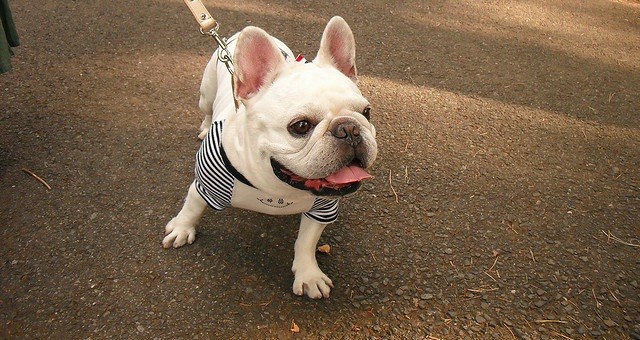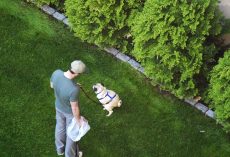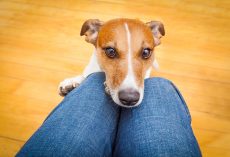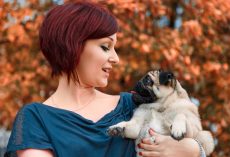Even if you think you know all there is to know about how your pooch communicates, there is always more to learn. A wagging tail doesn't always mean your pup is happy — it may mean he's being aggressive or is nervous about something.
To read your doggy's communication cues, look at more than just his face and tail, for example. Look at his overall posture. If he's alert, then his tail will be up, and he will be standing still. If he's relaxed, his tail should be relaxed too as well as the rest of his body.
Continue learning more about what your doggy is telling you on a daily basis on ASPCA. There's always more to learn!
Dogs are very expressive animals. They communicate when they’re feeling happy, sad, nervous, fearful and angry, and they use their faces and bodies to convey much of this information.
It helps to first learn about the various components that make up dog body language. Dogs use facial expressions, ear set, tail carriage and overall demeanor to signal their intentions and feelings to others. Breaking their body language down into components is helpful at first for building your observation and interpretation skills.
Dog Faces
Even though dogs’ faces and heads come in many shapes and sizes, your dog’s basic facial expressions can tell you a great deal about how he’s feeling.The Eyes
Your dog can, within limits, vary the shape and size of his eyes or the direction and intensity of his gaze. When your dog is relaxed and happy, his eyes will be their normal shape. Some dogs have round eyes, while others are more almond-shaped.The direction of your dog’s gaze can also be telling. Dogs rarely look directly into each other’s eyes because this is considered threatening behavior. Yet most dogs learn that it’s okay, even pleasant, to look directly at people.
The Mouth
Dogs do a lot more with their mouths than just eat and drink. Even though they can’t use their mouths to talk, the way they position their lips, jaws and teeth speaks volumes. When your dog is relaxed and happy, he’s likely to have his mouth closed or slightly opened. If his mouth is open, he may be panting—this is how dogs cool their bodies.A dog who’s frightened or feeling submissive probably has his mouth closed. His lips might be pulled back slightly at the corners. When he’s feeling uptight, he might yawn in an exaggerated fashion.
Some dogs show a “submissive grin” when they’re feeling extremely submissive. They pull their lips up vertically and display their front teeth (canines and incisors). People sometimes mistakenly think a dog is being aggressive when, in fact, he’s grinning submissively and trying to communicate the exact opposite of aggression.
However, once a dog is ready to bite, he usually pulls his lips up AND back so that his mouth is open and his teeth are exposed.
Dogs can display an “aggressive pucker.” They move their lips forward over their teeth and exhale air so that their lips look puffy and large. You can sometimes even hear them breathing heavily. This display is often accompanied by a wrinkled forehead. A dog who looks like this is saying, “Don’t come any closer.”
Dog Ears
Dogs have a wide variety of ear types. When your dog is relaxed and comfortable, he’ll hold his ears naturally. When he’s alert, he’ll raise them higher on his head and he’ll direct them toward whatever’s holding his interest. Your dog will also raise his ears up and forward when he’s feeling aggressive. If your dog has his ears pulled back slightly, he’s signalling his intention to be friendly. If his ears are completely flattened or stuck out to the sides of his head, he’s signalling that he’s frightened or feeling submissive.Dog Tails
People often assume that a dog with a wagging tail is a friendly dog, but this is far from the truth. Dogs wag their tails for numerous reasons, including when they’re feeling aggressive. And a dog who isn’t wagging his tail can still be friendly. A dog’s ability to use his tail to express how he feels is limited by the type of tail he has.When your dog is relaxed, he’ll hold his tail in its natural position. If he’s feeling happy, he may wag it gently from side to side. If he’s really happy, like when he greets you after being apart from you, his tail will wag more forcefully from side to side or might even move in a circular pattern.
When your dog is alert or aroused about something, he’ll probably hold his tail higher than normal. He’ll hold it stiff, without any movement.
Overall Body Posture
Dogs also use their bodies to communicate their intentions. In general, dogs either try to look normal, smaller or larger. If your dog’s feeling happy and contented, he’ll look normal—relaxed muscles and weight evenly balanced on all four feet.A submissive dog looks very similar to a frightened dog because he makes himself look small to convey that he’s not a threat.
An assertive (dominant), alert or aroused dog tries to make himself look large.
An angry, aggressive dog also makes himself appear larger than life to be as intimidating as possible. If your dog is aggressive, he’ll look very similar to an assertive, alert or aroused dog, but his posture will be accompanied by aggressive threats.
Putting It All Together—The Whole Dog
The messages dogs communicate with their body language can be subtle, but with careful attention, most people can learn to recognize and interpret the most important meanings. It’s crucial to know when your dog’s happy, when he’s playful, when he’s worried or scared, when he’s feeling uncertain or insecure about something or someone.Happy, Contented
When your dog is happy, he has relaxed body language. His muscles are relaxed, his tail and ears are held in their natural positions, and he looks neither large nor small for his physique. He might wag his tail from side to side or in a circular motion.Alert
When your dog is alert, he looks intense and focused. He stands upright with his weight centered on all fours, his ears are up and forward, and his head and neck are erect.Excited
When your dog is excited, he looks as intense as he does when he’s alert, but he might also adopt a playful demeanor. His body is ready for action. He looks natural in size, but his weight might be centered over his rear legs as he prepares to move.Aroused
When your dog is aroused, you might have a hard time distinguishing it from when he’s alert or excited. The only time it’s useful to know the difference is when the arousal pushes him closer to feeling frightened or aggressive. His body may look normal-sized or larger, his ears might be flattened to the side or held forward, and his tail might be held low, in a normal position or high.Playful
It’s fairly easy to detect when your dog’s feeling playful. His body movements are jerky and bouncy. He might bounce around in exaggerated twists, turns and leaps. He might dodge around you, paw at you and then take off running to invite a chase. Or he might just jump on you and start mouthing.Fearful, Scared
When your dog is scared, he does his best to look small. Often, his body looks hunched, with his tail held low or tucked between his rear legs and his ears flattened back on his skull. He might cower close to the ground. If escape is possible, he might lean so that his center of gravity is over his rear legs to permit a hasty retreat, or lean to the side so that he can recoil.Dominant
If your dog is feeling dominant, he stands tall, sometimes on his tiptoes, and tries to look large. He arches his neck. He appears tense, like a coiled spring. His weight is squarely on all four feet or he’s leaning forward slightly.Submissive
If your dog is feeling submissive while he interacts with a person or another dog, he tries to convey the message that he’s the underling, that he’s not a threat and that aggression is unnecessary. During active submission, he makes his body look small by hunching over and getting low to the ground.Your dog might switch from active submission to a more passive position, in which he lies down and rolls over on his back to display his inguinal area (his genitalia).
Fearfully Aggressive
If your dog is fearfully aggressive he won’t look any different than when he’s fearful, except that he might show his teeth and growl. Some fearful dogs never escalate to aggression, but others will if they feel there’s no escape. If he snaps or bites, it’s usually lightening quick, and then he retreats as far away from the threat as possible. Some dogs wait until the person or animal who frightens them begins to retreat, and then they dart out to nip them from behind.Offensively Aggressive
If your dog feels anger and confidence at the same time, you might see offensively aggressive body language. He’s on the attack, and he may or may not stop if the person or animal he’s focused on stays away or retreats.









